Explore the Southern flavors of Crock Pot Collard Greens, a simple and savory greens dish that's easy to make in your slow cooker. With ingredients like bacon and smoked ham, it's an easy recipe that allows anyone to enjoy the authentic taste of the South!
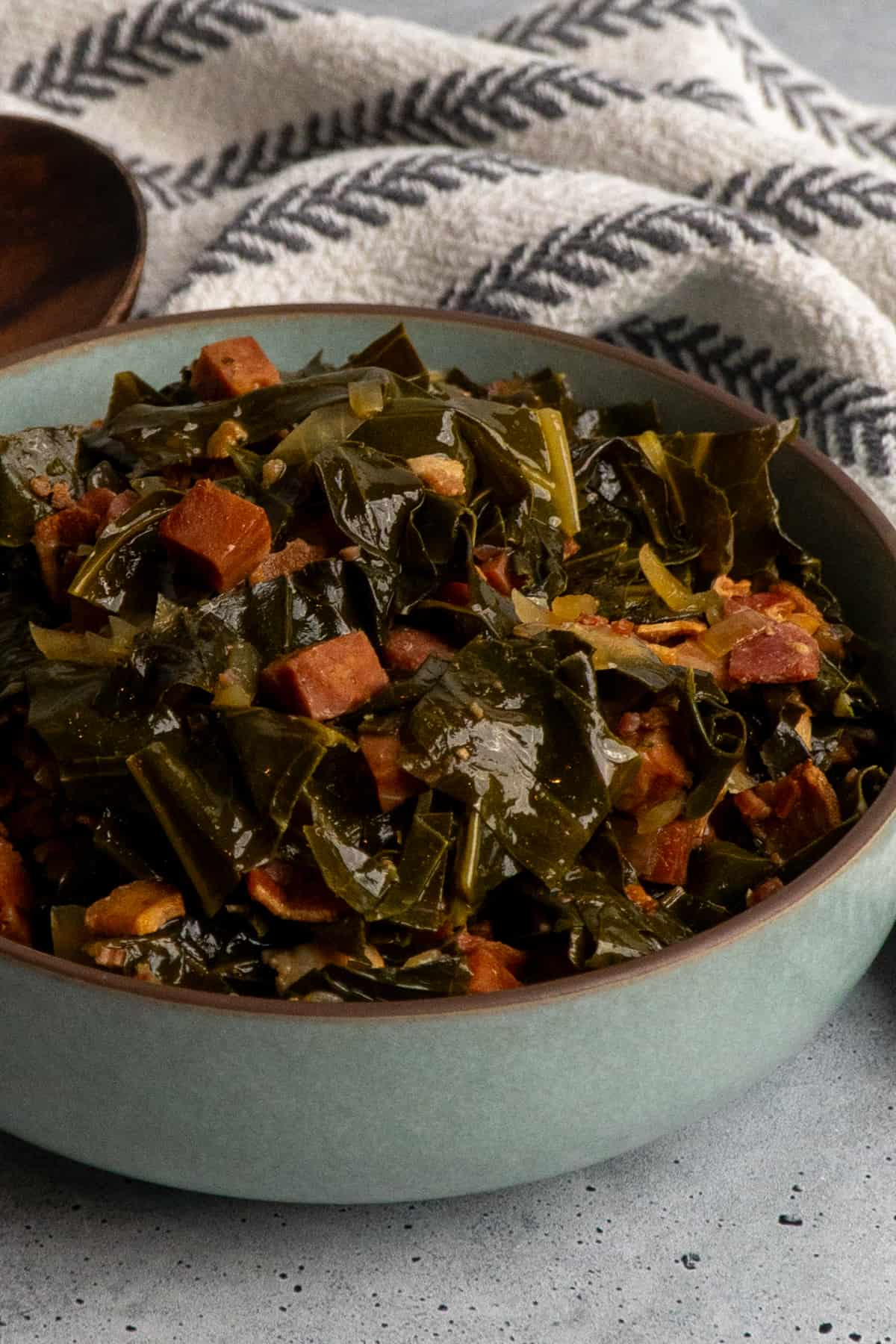
Crock Pot Collard Greens
Collard greens pair well with traditional Southern dishes such as cornbread or biscuits. Baby Back Ribs, Burnt Ends, Pork Belly Bites or BBQ Chicken Sandwiches are other popular choices for a southern meal.
Popular Right Now
Can you cook collard greens in the crock pot? Yes! Collard greens can be cooked in the crock pot because their leafy texture is great for slow, gentle simmering, especially when paired with ham and bacon for a salty, smoky kick that perfectly elevates the flavor. Ditch canned collard greens and try making them in your slow cooker for the best flavor and texture!
What Are Collard Greens?
Collard greens are leafy, dark-green vegetables that belong to the cabbage family. They're a Southern staple known for their hearty flavor and versatility. Collard greens have deep roots in Southern cuisine, often traced back to African and Native American influences.
Typically, they're cooked by simmering in a flavorful broth, often with smoked ham hocks or bacon for a rich, smoky taste. Garlic, onions, and a dash of vinegar are common seasonings, adding depth to the dish. Collard greens are slow-cooked until tender, absorbing all those delicious flavors.
While Southern-style collard greens are traditionally prepared in a large pot, the slow cooker is one of the best ways to cook them. Cook bacon until crispy, chop it, then layer it with onions, collard greens, smoked ham, and garlic in a crock pot. Season with pepper, sugar, chicken broth, and a bit of vinegar. Let it cook on high for 3½ - 4 hours or low for 7 - 8 hours. Stir, and you'll have a tasty Southern-style dish without needing to watch a pot!
Collard greens are a versatile dish often served as a hearty side at Southern gatherings and celebrations. They pair perfectly with classic fried chicken, Cornbread, and creamy Mac and Cheese, making for a comforting and soul-satisfying meal!
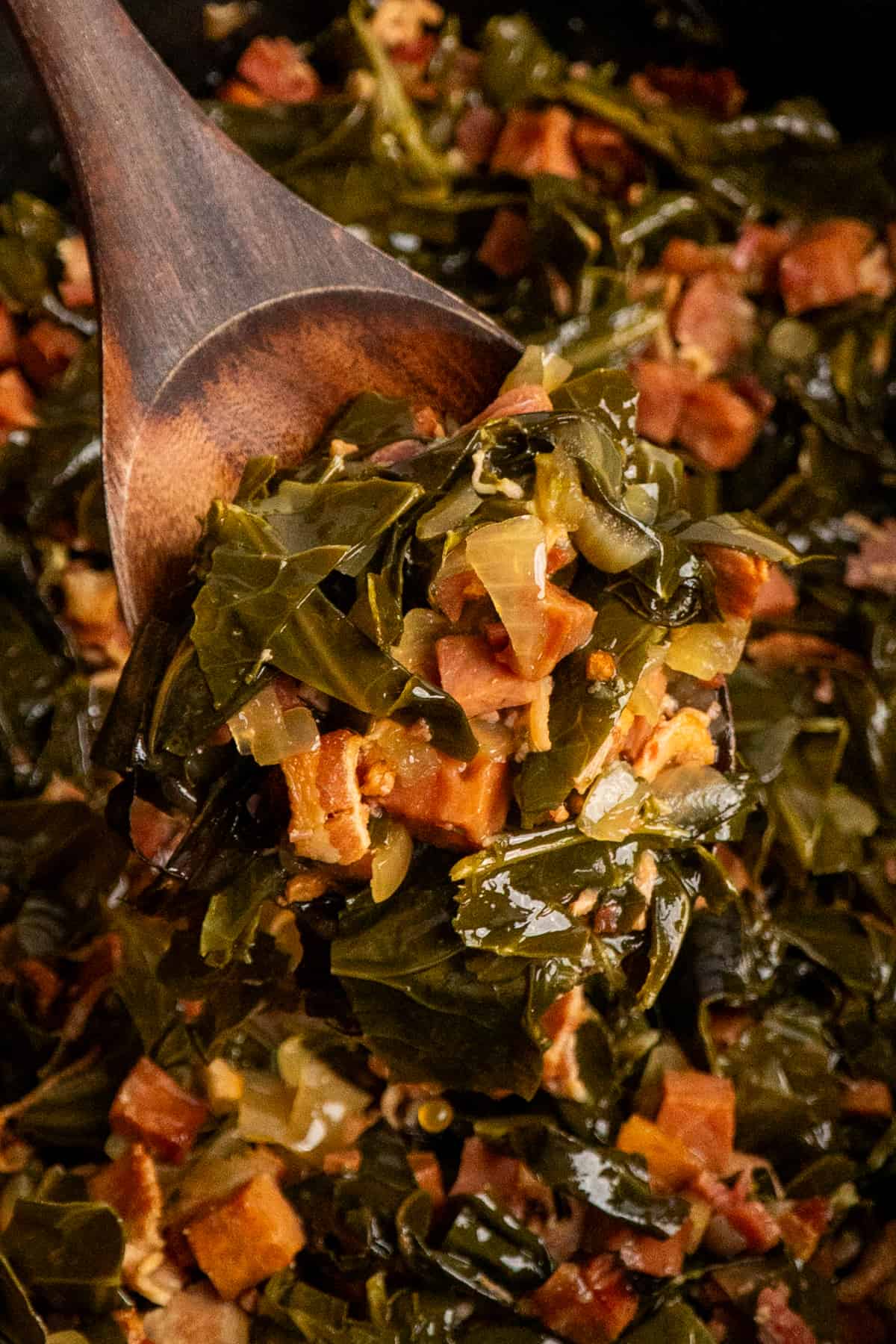
Why Make Collard Greens In The Crock Pot?
- Making collard greens in the crock pot is a time-saver; it does all the slow cooking for you, allowing you to focus on other tasks.
- Slow cooking infuses the greens with rich, smoky flavors from bacon and ham, resulting in a smoky, salty, traditional taste.
- The collard greens become tender and soak up all the savory seasonings, creating a consistently delicious side dish.
- This recipe is ideal for gatherings as it can easily serve a crowd without requiring constant attention.
Ingredients For Crock Pot Collard Greens
- Thick Cut Bacon - Adds a savory, smoky flavor and a crispy texture when cooked.
- Garlic and Onion - Bring aromatic depth and a mild, savory sweetness that balances the flavor.
- Collard Greens - Provide a hearty, slightly bitter, leafy green base that softens and absorbs seasonings.
- Smoked Ham - Contributes an additional layer of smokiness and saltiness used in Southern cooking.
- Chicken Broth - Serves as the cooking liquid, keeping the dish moist while adding flavor.
- Apple Cider Vinegar - Adds a subtle tangy note to balance the richness and enhance the flavor.
- Black Pepper - Provides a mild heat and a peppery kick.
- Sugar - Adds a hint of sweetness to counterbalance the savory and smoky flavors.
How To Make Crock Pot Collard Greens
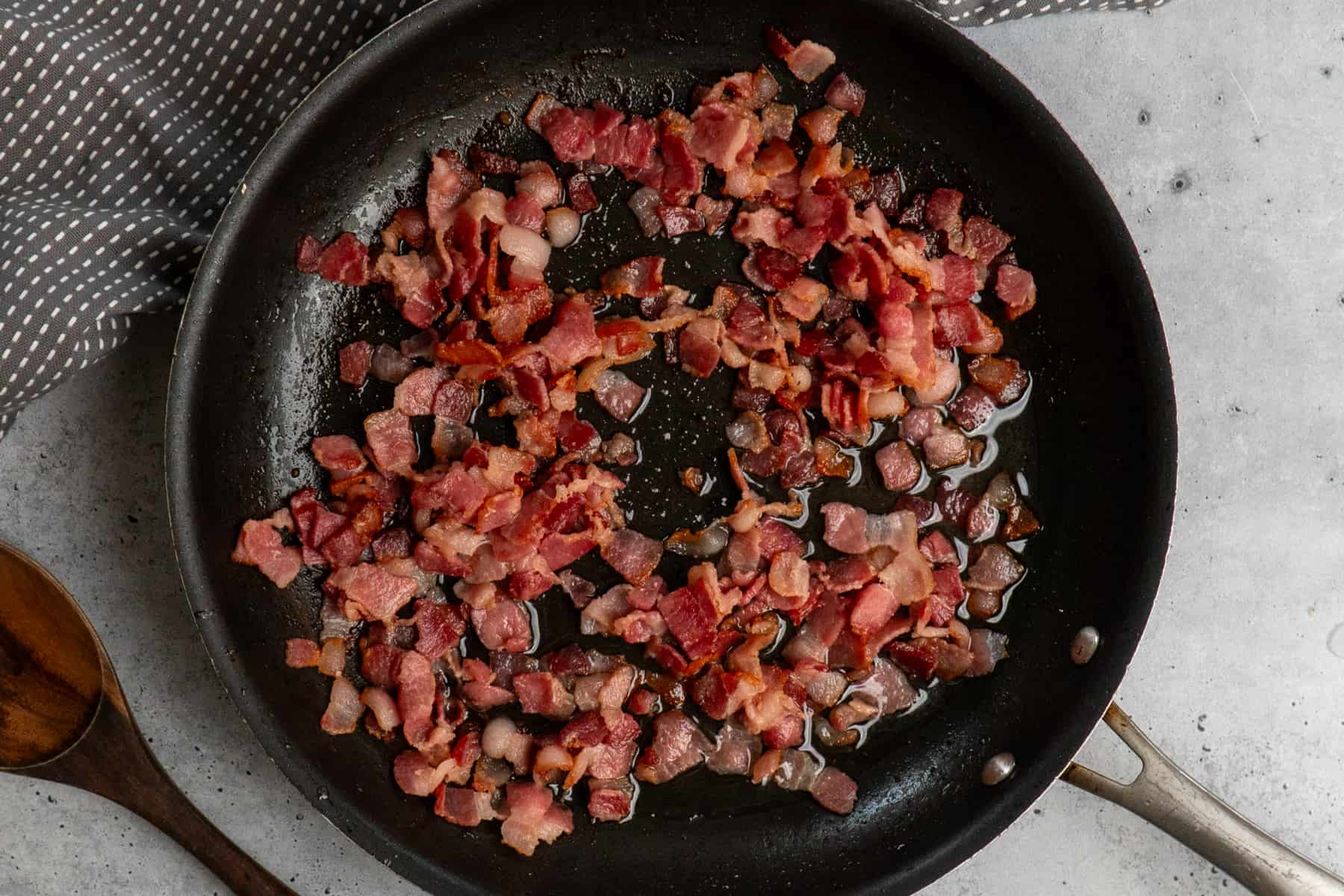
Cook the bacon: Add the thick-cut bacon to a large skillet over medium heat. Fry until crispy, then drain on a paper towel-lined plate to absorb excess fat. Chop into pieces with a sharp knife and set aside.
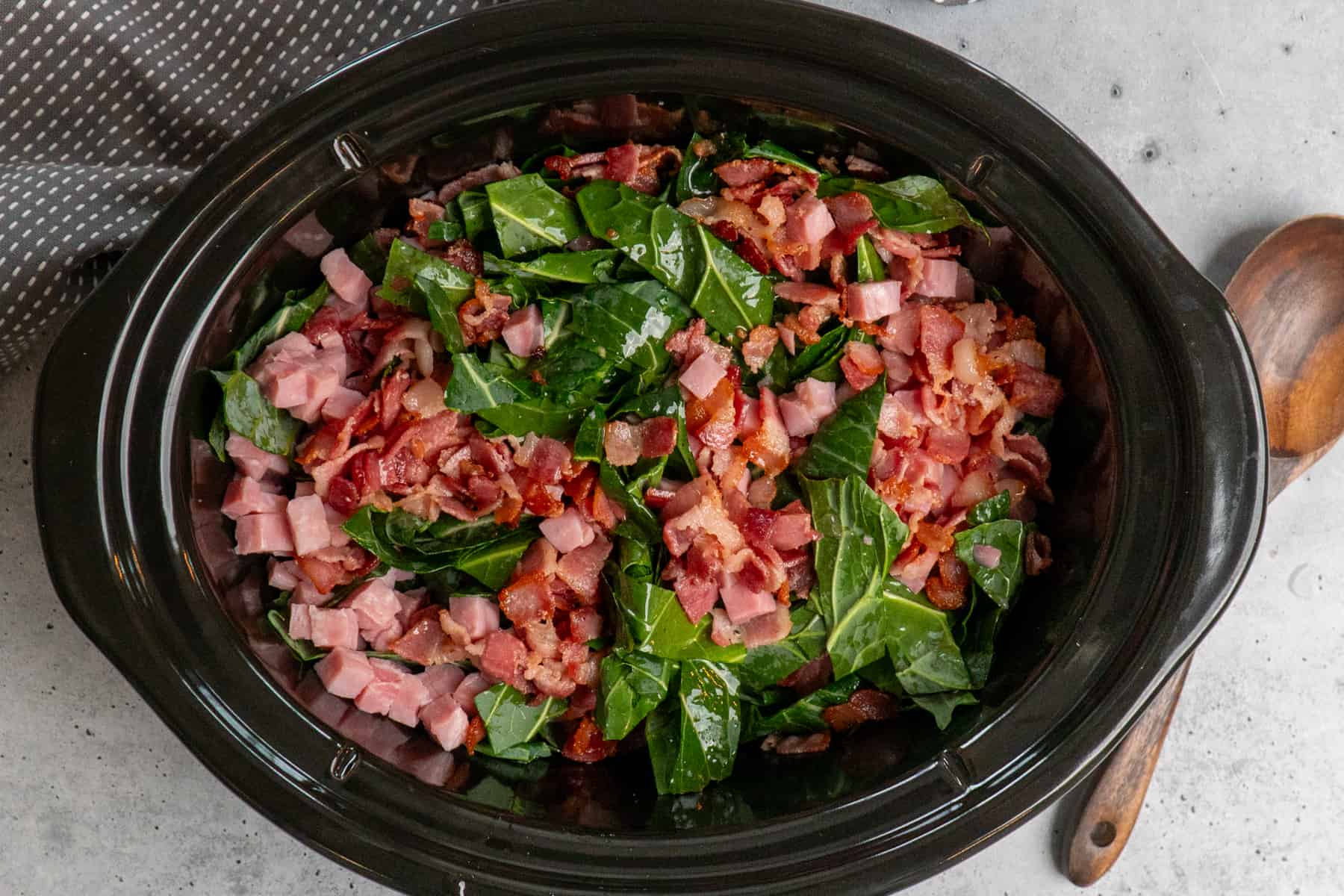
Layer the ingredients: Add the ingredients to the crock pot by layering the onions on the bottom first, followed by the collard greens, smoked ham, bacon, and garlic; pour the chicken broth and apple cider vinegar on top, followed by a sprinkle of black pepper and sugar.
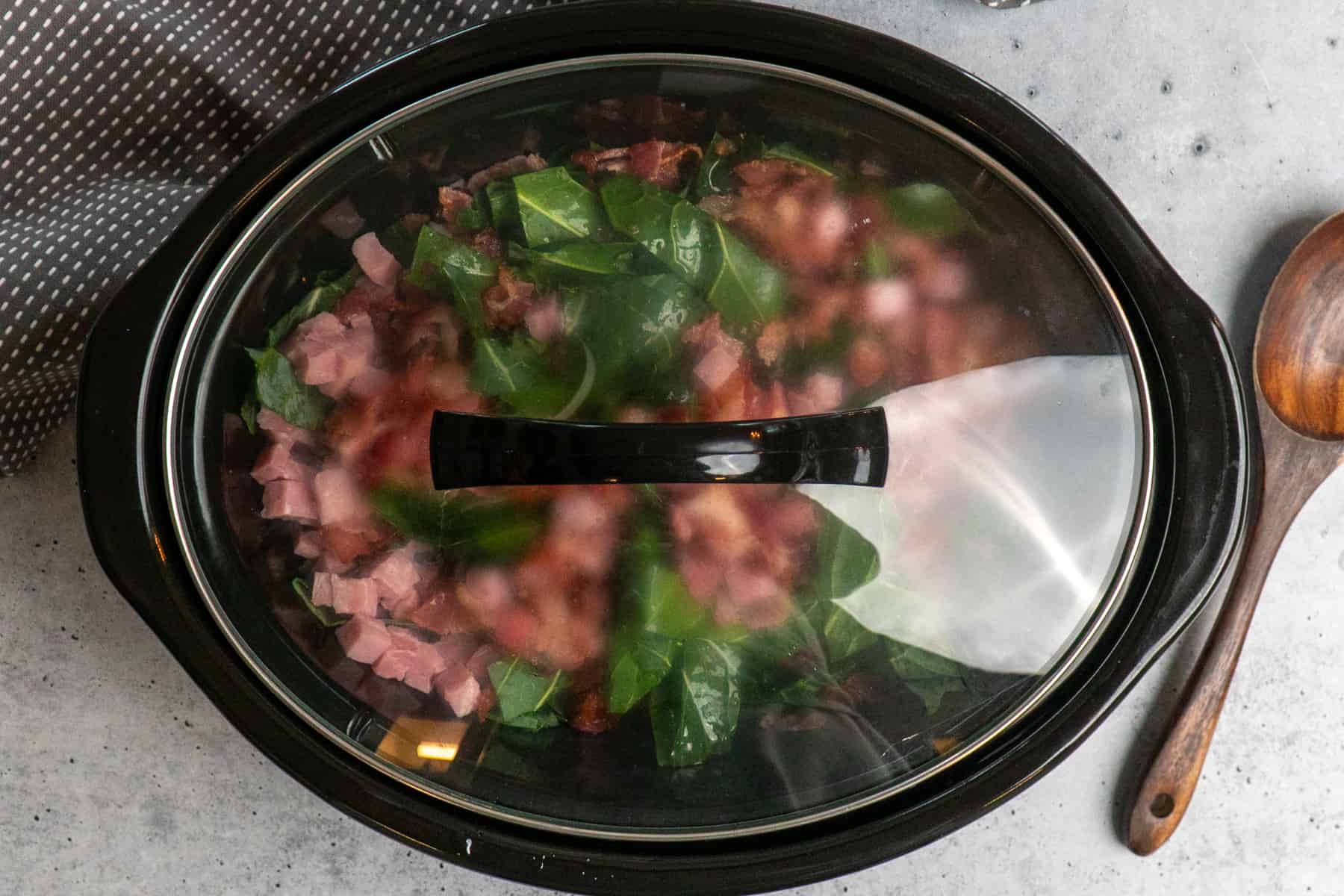
Cover and cook: Add the lid to the top and cook on HIGH for 3½ - 4 hours or on LOW for 7-8 hours. Or until the greens are tender and soft.
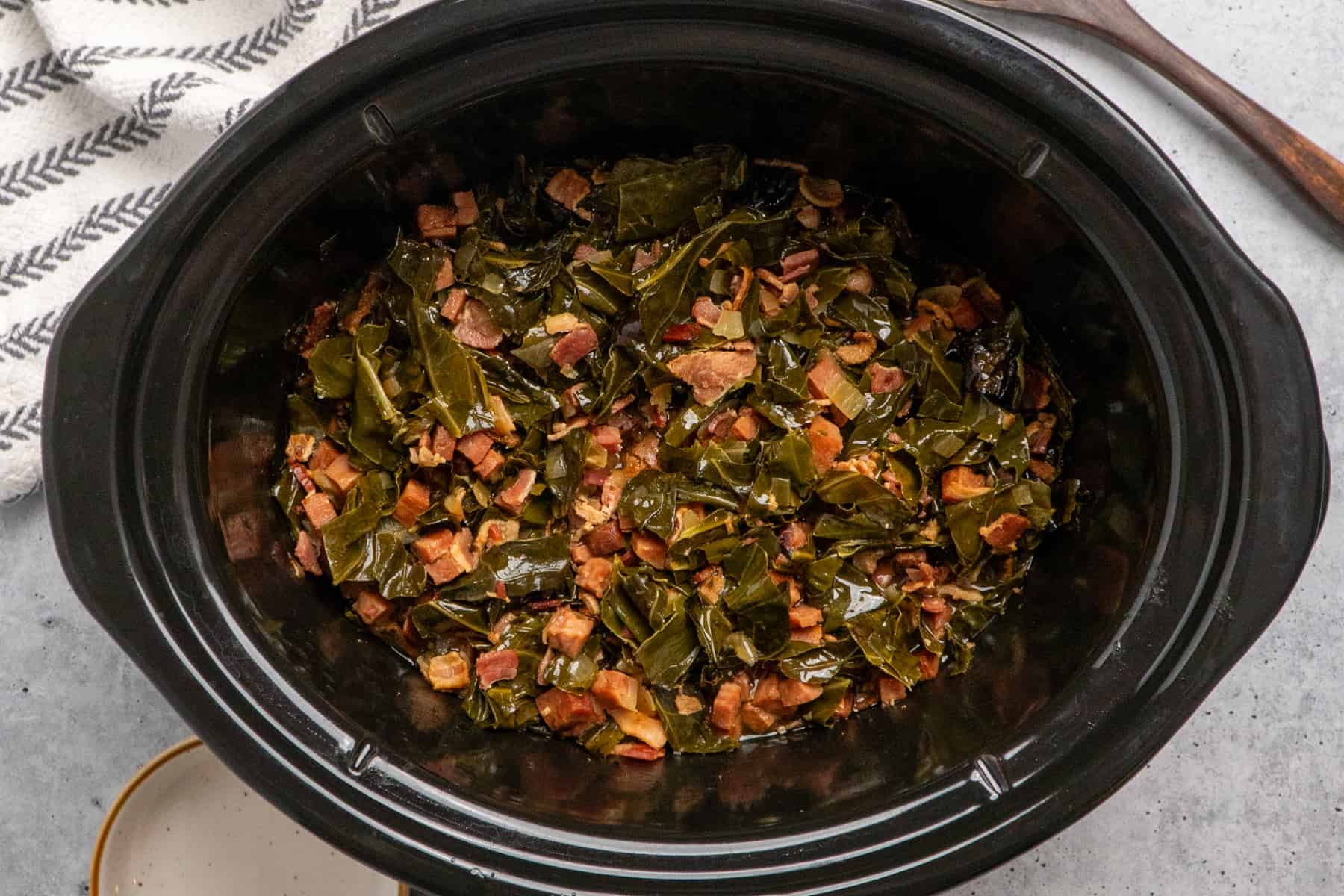
Serve and enjoy: Stir to incorporate the ingredients evenly. Serve while hot with your favorite mains and sides. Enjoy!
Cooking Tips
- To save time, you can use bagged collard greens, but ensure they're well-washed and the woody stem parts are removed to maintain optimal flavor and texture.
- When frying the bacon, cook it until it's crisp but not overly browned; this ensures it retains its smoky goodness without becoming too crunchy.
- Use low-sodium chicken broth to have better control over the saltiness of your dish; you can always adjust the seasoning to taste later.
- How long to cook collard greens in the crock pot will depend. If cooking on high, it typically takes around 3½ to 4 hours for them to become tender and infused with flavors. On the low setting, allow them to simmer for about 7 to 8 hours, ensuring they reach that perfect balance of tenderness and flavor absorption. The cooking time may vary slightly based on your specific crock pot or the thickness of the greens. Check often before the end of the cooking time to ensure they don't overcook.
Flavor Variations and Substitutions
- Enhance the spiciness of your collard greens by adding a pinch of red pepper flakes along with the black pepper.
- Experiment with different greens like kale or mustard greens for a unique twist on the traditional recipe.
- Substitute smoked turkey leg or smoked sausage for the smoked ham.
- For a vegetarian option, omit the meat entirely and use a dash of liquid smoke or smoked paprika along with vegetable broth instead of chicken broth.
- Add a splash of white wine or apple juice to the crock pot for a touch of fruity acidity and complexity in the dish. Incorporate a dash of Worcestershire sauce or soy sauce for an umami-rich depth of flavor.
- Drizzle a bit of maple syrup or honey over the collard greens during cooking.
- Mix in some sautéed mushrooms for an earthy, hearty twist that pairs well with the greens.
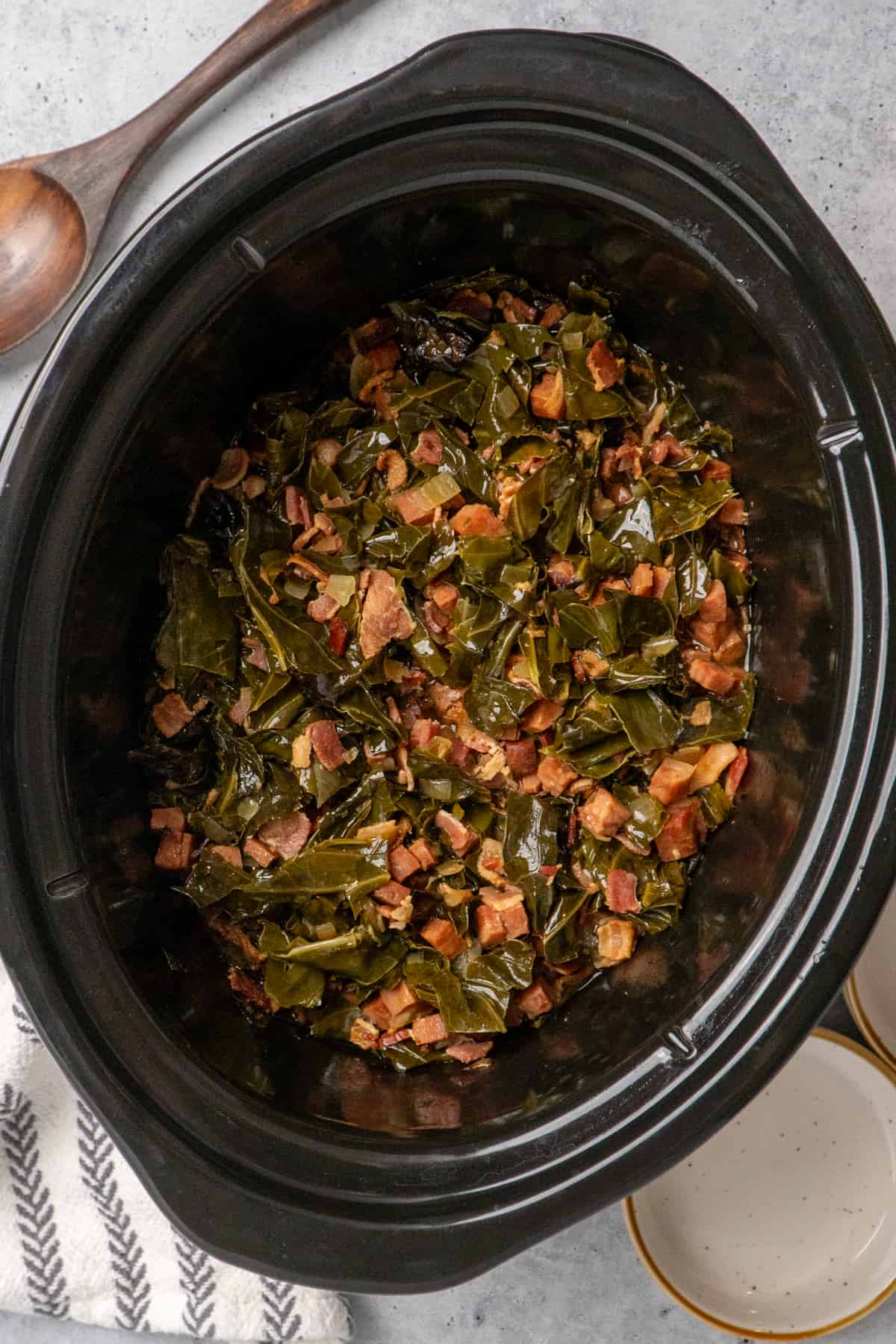
Storage
Storing: Place leftovers in an airtight container in the refrigerator, where they'll remain fresh for 3-4 days.
Freezing: Collard greens are not ideal for freezing because they become mushy when thawed, resulting in a less appealing texture and flavor. Therefore freezing is not recommended.
Reheating: When reheating collard greens, gently warm them on the stove over low to medium heat, stirring occasionally until they are heated through.
FAQ
It's best to avoid frozen collard greens, as they can become mushy when cooked in the crock pot. Fresh or bagged collard greens work best for this recipe.
Yes, you can substitute apple cider vinegar with white or red wine vinegar if needed. It will add a slightly different flavor but still work well in the recipe.
To reduce bitterness, add a pinch of sugar or a splash of vinegar during cooking to balance the flavors. Both are in this recipe and help counteract any bitter flavor that occurs naturally in the greens.
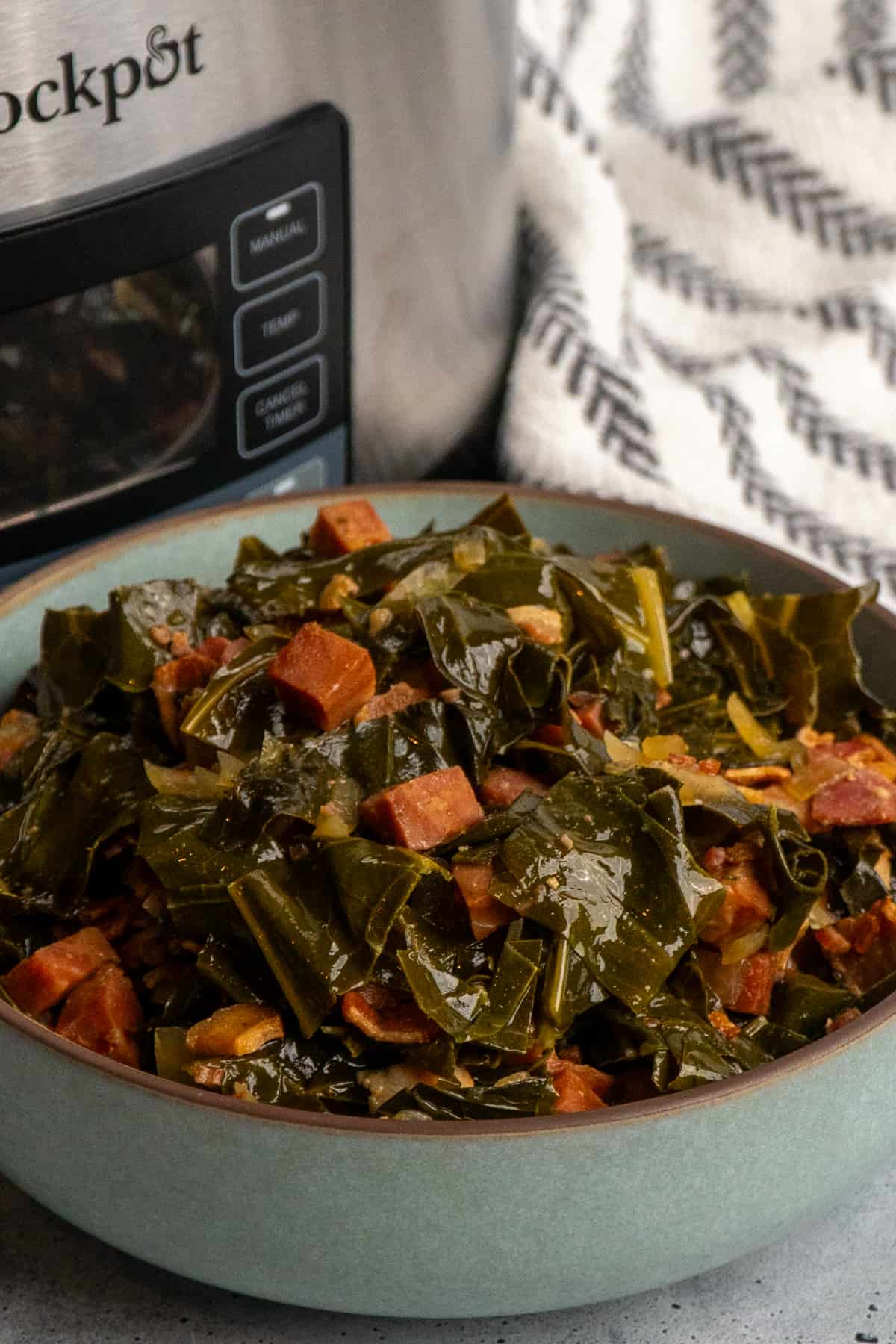
More Crock Pot Vegetable Side Dishes
SHARE IT & RATE IT
Did you make these crock pot collard greens? Leave a 5 Star ⭐️⭐️⭐️⭐️⭐️ rating below. Then follow me on Facebook, Instagram, and Pinterest! Share your favorite recipes or ask questions in my Facebook Group.
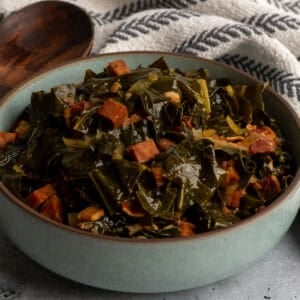
Crock Pot Collard Greens Recipe
Ingredients
- ½ lb thick cut bacon
- 1 medium yellow onion (diced)
- 8 cups collard greens (remove the ribs and stems, then chop the greens into pieces)
- ½ lb smoked ham (chopped)
- 4 tsp garlic (minced)
- 3 cups chicken broth
- ¼ cup apple cider vinegar
- 1 tsp black pepper
- 1 tbsp sugar
Instructions
- In a large skillet over medium heat. Cook the bacon until browned and crisp. Drain fat and chop. Set aside.
- Place the onions in a 6 quart crock pot. Then, top with collard greens, smoked ham, and bacon.
- Add garlic, chicken broth, apple cider vinegar, black pepper and sugar.
- Cover and cook on high for 3½ - 4 hours or on low for 7 - 8 hours.
- Stir before serving, and enjoy!
Nutrition
*Nutrition information is an estimate. It may vary based on ingredients, brands, and changes in cooking methods listed in the recipe. If you need exact ingredient numbers, I recommend calculating them with your preferred nutrition calculator.

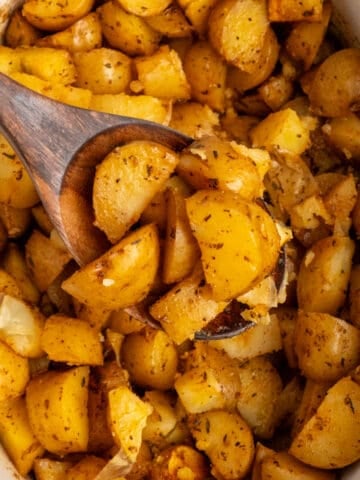
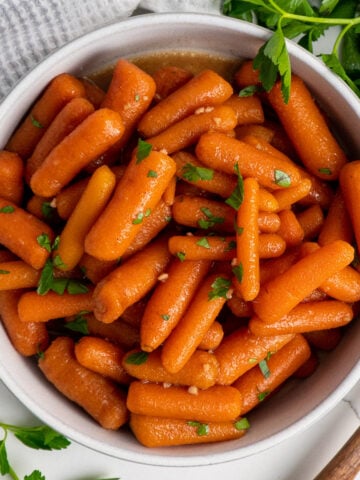
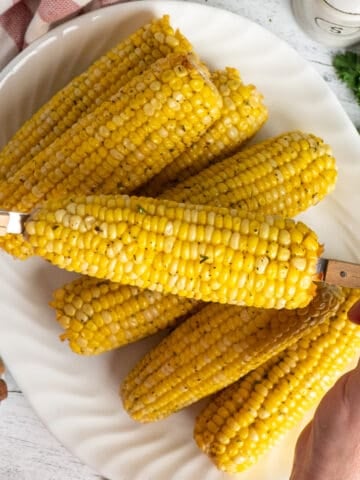
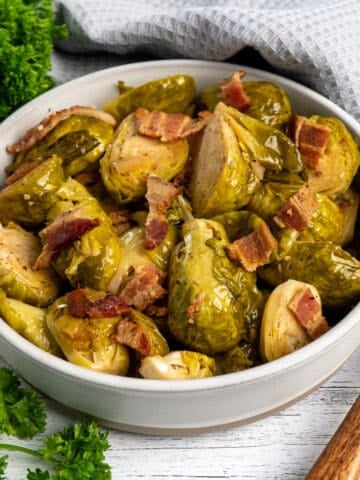

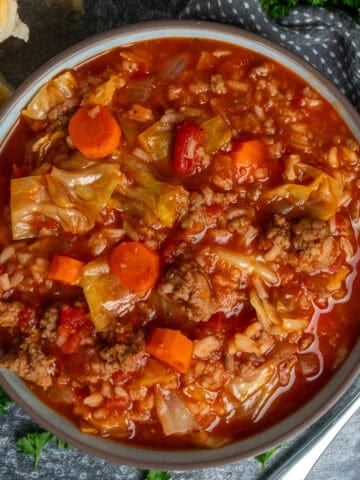


Leave a Reply